After investing time and effort into growing pepper plants from seed, seeing them slump over is dispiriting. They suffer for their own fruitful success as they grow, they can become heavy and unwieldy, leading to drooping branches and damaged stems. That’s why it’s essential to provide proper support by fastening them to stakes, cages, or ropes. By training the plants to grow upward along these supports, they can avoid crawling along the ground, where they are prone to contracting diseases. In this article, we’ll explore the answer of do pepper plants need support and how to stake pepper plants, and the various ways to provide it.
From choosing the right materials and techniques to positioning your stakes for visible growth, I’ll cover everything you need to know to help your pepper plants flourish.
Keep reading to discover how to keep your paper plant sturdy and strong.
Table of Contents
Overview of Pepper Plants
Pepper plants come in a vast range of varieties, differing in size, color, and Scoville Heat Units, and some of my favorite ones in terms of taste and growth patterns are:
| Name | Growth habit | Scoville Heat Units |
|---|---|---|
| Bell Pepper | Bell peppers are vitamin-rich pepper with a mild taste and varied colors, needing low nitrogen fertilizer, well-draining loamy soil, sun, and 60-90 days to grow fully. | 0 |
| Siling Labuyo | Tiny hot chili pepper with upward-growing triangular fruits and small, pointed leaves. | 80000 to 100000 |
| Jalapeño Pepper | Jalapeño is an easy and fast-growing, mildly hot chili pepper from Mexico and wildly popular for its flavor and mild heat. | 2000 to 8000 |
| Banana Pepper | The banana pepper is a mild, sweet chili pepper named for its curved, yellow fruit resembling a banana. | 0 to 500 |
| Serrano Pepper | Hotter than jalapeño and found in green to brown colors, is eaten raw in salsas or cooked in soups, grows up to 5 feet tall, and can produce over 50 peppers. | 6000 to 25000 |
1. Bell Pepper (Capsicum Annuum)
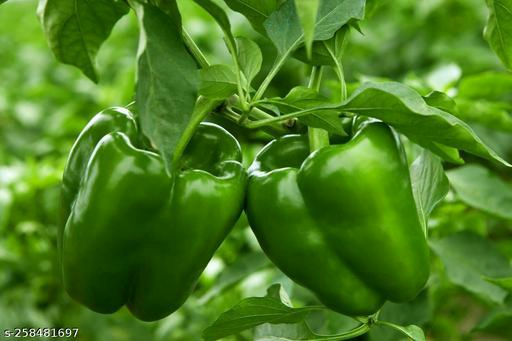
Bell paper is one of the most popular pepper types. Widely used for its mild taste and variety of colors(yellow, red, and green). They are eaten in every form raw. baked, and cooked. Bell peppers are rich in vitamins A and C.
Low nitrogen level fertilizers, well-draining loamy soil, and a good amount of sun if perfect for them. They take around sixty to ninety days for their full growth.
2. Siling Labuyo (Capsicum frutescens ‘Siling labuyo’)

Siling Labuyo is the world’s most miniature hot chili pepper with triangular fruits that grow upwards and small, extended leaves with pointy tips. They are similar in appearance to Thai chilies but are more rounded and shorter in size.
Best cultivating requirements for these plants include moist soil and partial shade, with temperatures between 15°C and 25°C.
3. Jalapeño Pepper (Capsicum Annuum ‘Jalapeño’)
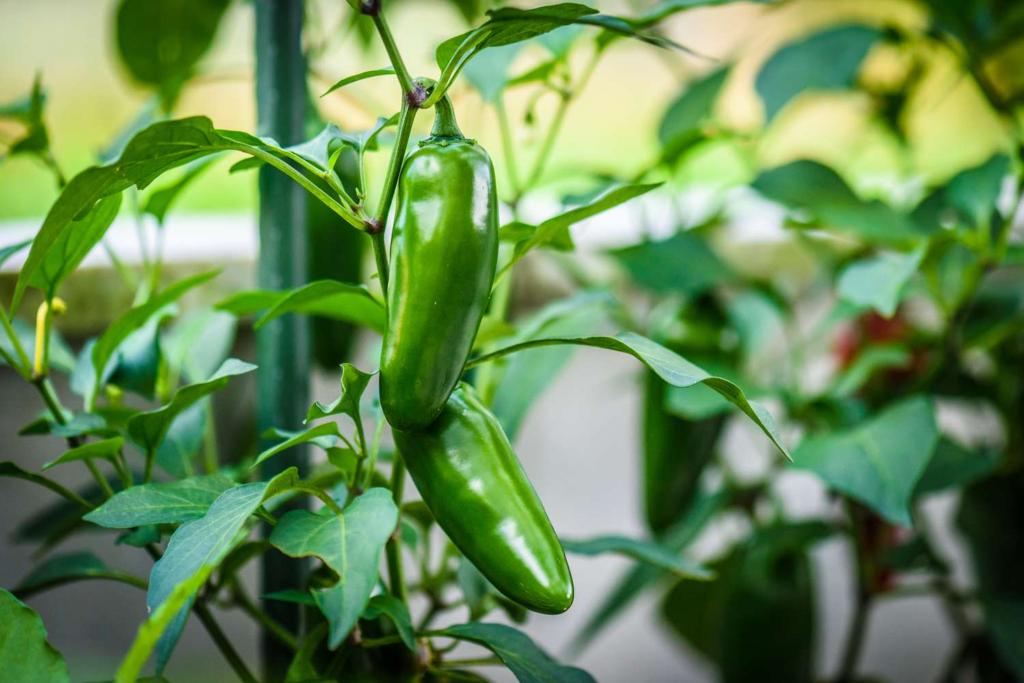
One of the easiest and fastest-growing pepper types. Jalapeño is a mildly hot chili pepper from Mexico. They can grow up to 6 inches but are usually harvested when they are 2 to 3 inches long. Plants reach 2 to 3 feet tall and produce 30 to 40 green peppers in about 80 days.
4. Banana Pepper (Capsicum Annuum ‘Sweet Banana’)
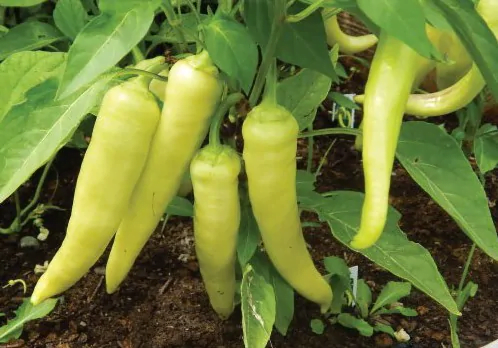
The banana pepper is a sweet chili pepper named for its resemblance to a banana, with curved, yellow fruit. Despite being one of the chili pepper types, it’s mild and commonly used in salads and sandwiches due to its sweet flavor.
Plants grow 18-24 inches, and prefer rich, well-draining soil, full sun, and balanced/low-nitrogen fertilizer, with harvest in around 70 days and sometimes requiring staking.
5. Serrano Pepper (Capsicum Annuum ‘Serrano’)
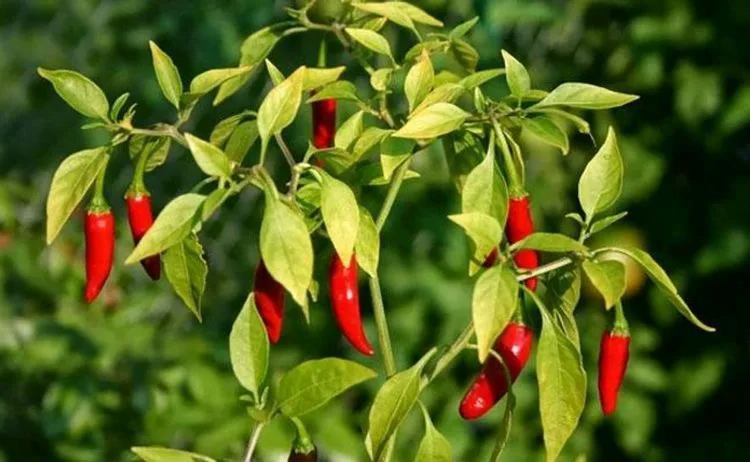
One of the hottest chili peppers from Mexico, the Serrano pepper, originating from Puebla and Hidalgo states, is smaller but hotter than the Jalapeno pepper (10,000 to 25,000 SHU) and comes in various colors, from green to brown. It is eaten raw in salsas or cooked in soups.
They can grow up to five feet tall and prefer 20-23 degrees Celsius. At a time they can produce over 50 peppers.
Do pepper plants need support and When to Stake Pepper Plants
Here are some scenarios in which staking your plants moves from optional to mandatory.
You get heavy rains:
Long growing seasons can cause peppers to grow taller, while areas prone to thunderstorms require proper staking to prevent a pepper-loaded plant from being quickly grounded.
Rain is ideal for the lushness of a garden. But, too much rain can be dangerous. Also, it will help the fungi to proliferate, rain also gives more weight to a plant’s surface. After a month of almost daily rain in June and July, even the most erect pepper plants in your garden can take a profound and reverent bow.
Your pepper plants get loaded with peppers during the growing season:
Without the support of a stake, pepper plants during the end of their growing season can lead to broken branches due to the weight of the peppers, resulting in damage to both the plant and its fruit as well. Staking pepper plants in large pepper varieties profit from extra support to withstand the weight of their own yield.
Smaller pepper varieties like banana, and serrano, jalapeno need support through staking the plants by tying off the main stem a few inches off the ground and every 4 to 6 inches of growth above.
Large varieties such as bell peppers require support for both the main stem and heavily loaded branches to stop them from snapping.
Different Techniques for Staking Pepper Plants
Staking pepper plants or supporting pepper plants can be done in three different ways, they are;
1. Single stake method and Double stake method:
2. Caging method
3. String or rope trellis support method
1. Single stake method and Double stake method
Material needed: Stake made out of bamboo, wood, plastic, or metal; Twine; scissors.
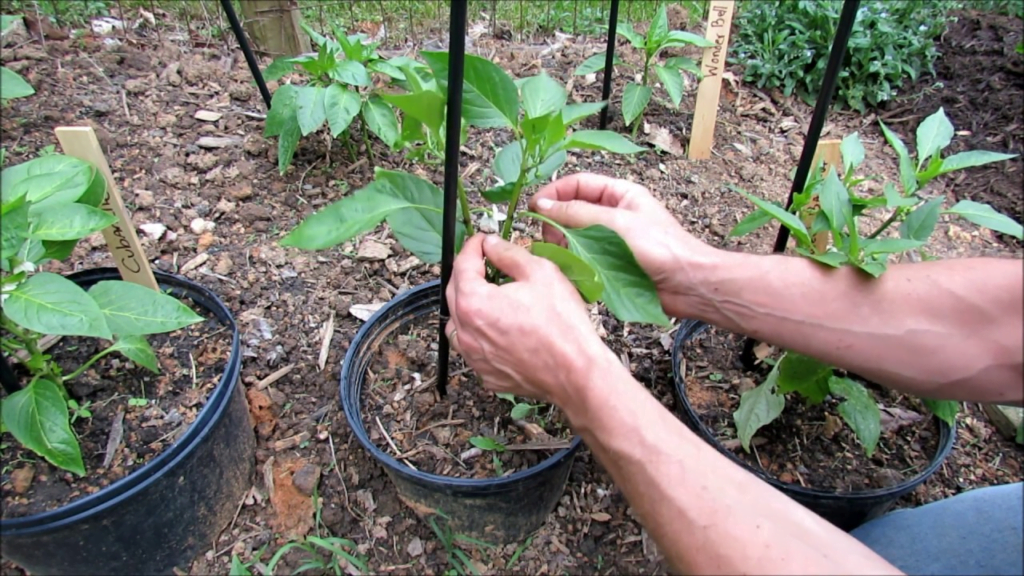
How to: Average full growth height of a pepper plant is around three feet tall, so you don’t require a stake that is more than 4-5 feet (but you can use taller stakes, it won’t cause any harm but will give extra underground support).
Inject the stake into one foot the ground a couple of inches away from the base of the plant, in order to not hurt the roots. Now use twine to secure your pepper plants by tying them at regular intervals.
The double staking pepper plants method is similar but with two stakes placed on two sides of the plant to provide extra support. Smaller pepper species (banana, jalapeno) doesn’t require double staking.
Tips: It’s better to stake early than in the middle of the growing season, so they can get habituated to the shape they will grow.
DIY stake: Any straight and long objects around your house such as broom handles, and pool cues can be used as a stake.
2. Caging method
Materials needed: Cage, Ground Anchor( if the cage is extensionless), tie.
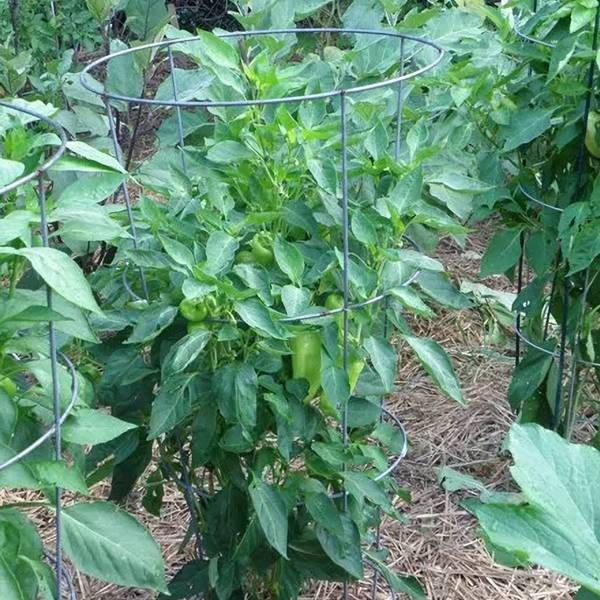
How to: It’s best to use the cage support method when the plants are in their seedling phase, so as they grow you just have to tie the required parts around the cage. So, caging is an elevated form of staking pepper plants.
Anyways, place the cage around the plant (for potted plants diameter of the cage is restricted according to the diameter of the pot).
Push the cage into the soil, gardening cages come with extensions that are made for easy to pierce in the soil, or else you can use a Ground anchor to secure the cage around the plant. Detect and tie the branches once they started growing.
However, cages are a secure method but it makes the harvesting, watering, and fertilizing process a bit difficult.
DIY cage: Chicken wire can be used as a cage or you can make a cage out of any wire.
3. String or rope trellis support method
Materials needed: Support structure, string, garden staple.
I have searched and tried different kinds of support systems for pepper plants and I can proudly say that string or rope trellis is most effective and cheap when it comes to mass production.
How to: Create your support structure higher than your pepper plants’ reaching potential (the average growth of pepper plants is 3 feet, so leave two-three extra feet above the said height). Tie strings or rope to the top of the structure aligning with the plant. Secure the string with a garden staple to the ground. Staple it near the plant or plant the seedlings near the strings. Continue to wind the pepper plants up the string as they get taller.

In the above picture string trellis is done for tomato plants, but the idea is the same.
Staking Young Pepper Plants
Staking pepper plants in their younger stage is an important step in securing their healthy development.
You can stake the seedling when they are about six to eight inches tall. During this phase plants are delicate along with their roots, so using small stakes such as bamboo skewers[Amazon product link] is advisable to use to assure not to create any unnecessary damage to the roots (you don’t need heavy-duty stakes in that phase anyway!). This will be enough to help support the stem and keep it from falling over or breaking in its next growth phase. Be gentle while tying the stem too!
Staking Mature Pepper Plants
Staking mature pepper plants requires heavy-duty stakes that can resist the weight of the mature plants. You can use metal stakes[Amazon product link] as they are the hardest ones.
It’s advised to stake mature plants before they begin to flower. To manage the weight of mature plants, tie the stems to the stakes at intervals with a soft twine or plant tie. As the plants grow and produce fruit, additional ties may be necessary to support the weight of the peppers. As the stakes are hardy it’s important to be gentle while tying it with the plant and piercing it in the soil. You don’t wanna strangle the plant or ruin the roots.
Tips for staking pepper plants:
1. Most peppers are easy to be blown over by a strong breeze, and a single, main stake or frame is usually all the help required.
2. By growing peppers closer to one another, they will help each other to stand straight, usually they need little or no staking. But, it may become more challenging to perform normal tasks like accessing the plants for harvesting, fertilizing, and watering.
3. Small red chilies like Thai tabasco, and Shishito peppers don’t need trailing frames or caging, a single stake is sufficient to keep them upright.
4. Bell peppers, Habanero peppers, Ghost peppers, and almost all Capsicum Chinese-type peppers require additional support as they have heavy branches, so caging will help.
5. If your stakes are tall enough, you can use them as a garden pest blocker. Just tie something lightweight and glossy on the top – they will bobble around in the wind, producing noise and reflecting light.
6. Tie the plant just over the node on the central stem to ensure the tie won’t move as the plant continues to increase.
7. Sharpen the end of the stick you are using before staking. This will let the branch slip between the root system more swiftly.
Maintenance of Staked Pepper Plants
1. Regular check-ups
As there are alien objects involved in your plants’ growing process, regular observations are required, because if those stakes or ties are causing any inconvenience they won’t be able to fix it by themselves.
Plants grow gradually and their stems become thick, so it’s essential to make sure the ties are not tight enough to suffocate them.
Loosen the tie a bit every now and then.
You might need to take the stake out and redo it by increasing the distance a bit if it’s standing as an obstacle to root growth.
2. Pruning and trimming
Pruning peppers improve branching, roots, and late-season fruit ripening by changing their growth pattern.
Early tip pruning creates stout, wind-resistant plants with higher branching and increased fruit production.
Pruning pepper plants in spring and late in the season is ideal to establish a strong branch structure, encourage root development, and manage diseases. Late-season pruning should be focused on the plant’s energy in the maturing fruits. Eliminate any branches that are fruitless and also get rid of flowers and small fruits that are improbable to ripen before the first frost.
Common Mistakes you should Avoid When Staking Pepper Plants
1. Using the wrong stakes
When staking pepper plants, it’s necessary to choose stakes that are tall enough to support the plant’s transition for the next few months. A fine rule of thumb is to pick stakes that are about a foot taller than your plant’s starting height. This reduces the need for adding new stakes later on. As your plant grows, add more ties to provide additional support. Also, avoid using treated or stained wooden stakes as they may contain harmful chemicals that can leach into the plant.
2. Improper Placement
When you are staking pepper plants, you need to look out for the place you are injecting your stake.
Cause staking too close to the plant will definitely damage the roots.
So, sidestep the main root structure in the process.
For indoor or potted plants, set the stake near the rim of the pot instead of the middle, so that it can also provide more space for the plant to grow.
3. Overstaking or under-staking
In over-staking, we tend to ignore the size of the plant and the stake we are using or we use more stakes than the plan’s need. In under-staking, we use small, thin, or improper stakes. In both cases, our plants pay for our mistakes. Because of over-staking plants’ roots get affected, and too much amount of stakes prevents plants to get natural airflow and can invite fungus attacks. Under-staking causes the plant to bend over (literally useless!).
Conclusion
In conclusion, providing support boosts the effective growth of your pepper plant. We discussed what are some of the best pepper species, what kind of staking and supporting your plant needs, and common issues that you should be vigilant about after staking. So, get the type of stake that is suitable for the plant and let it showcase its fruitfulness upright!
Faqs
Q1. How tall should the stakes be?
We can calculate the height of the stake. Suppose six inches to one foot under the ground + ideal height of the plant (3 feet) + one or two feet for extra space. So, a five to six feet stake is ideal for most of the pepper plant species.
Q2. Can I use recycled materials for staking?
Any long and straight object can be used for staking. Unused leftover hard pipes, broom handles anything as long as they are made of metal, plastic, or wood and they are weather resistant.
Q3. How do I remove stakes?
To remove stakes from your pepper plant, first, loosen any ties or supports holding the plant to the stake. Gently rock the stake back and forth to loosen it from the soil.
If the stake is difficult to remove, tease the soil around the stake. Carefully lift the stake out of the soil, and be aware not to harm the roots. Once the stake is removed, you can prune or maintain your pepper plant as you want.
Q4. Should I stake all my pepper plants?
Even though many pepper plants are strong and sturdy and they can hold themselves upright, it’s ideal to provide a stake for some extra support.
Q5. Can I Use a Tomato Cage for Staking Peppers?
Tomato cages can be utilized to support peppers as well. To be honest, I think tomato cages are more beneficial for pepper plants, mainly for the big varieties or types with loaded fruit production than they are for some tomatoes.
The tomato cages are perfect for supporting hanging branches and heavy fruits, like banana peppers or bell peppers. They are also perfect for any Chinese pepper variety plants, as they usually branch heavily.
The size of tomato cages is also ideal for peppers, too, at around 4′ in height from the surface of the soil. They are recyclable and can create a nice, even formation in the pepper garden.
Related Articles
- Propagating Chinese Elm Bonsai Cuttings And From Seeds
- Best Chinese Elm Bonsai Soil and Fertilizer.
- Troubleshooting Common Problems With Chinese Elm Bonsai
- Buy Chinese Elm Bonsai: How Not to Get Scammed When Purchasing a Chinese Elm Bonsai Tree!
- Chinese Elm Bonsai Pruning And Styling.
- Creating a Chinese Elm Bonsai Forest- Step-By-Step Guide.

